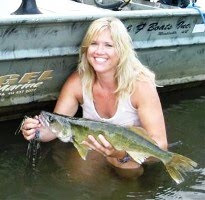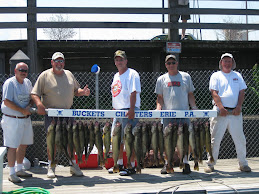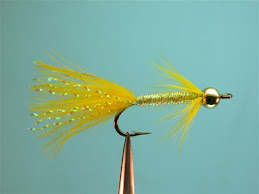
Andy Nguyen with one of his huge walleyes.
by Deborah Weisberg
For local river anglers, Thanksgiving is as much about walleyes as turkeys.
The fall holiday typically marks the start of the big walleye bite on the Allegheny, Monongahela and Ohio rivers. This year, though, it may have begun a little sooner, with reports of several trophy-size ‘eyes taking the bait at the Highland Park Dam, lock three and other spots in recent weeks. One of the biggest was the 12-pound, 34-incher Andy Nguyen landed on a shiner in the white water of the Ohio River’s back channel dam Nov. 5.
“The bite may be a little early because water temperatures are a tad colder than normal,” said Pennsylvania Fish and Boat Commission biologist Rick Lorson.
Anglers also may be seeing walleyes from a couple of exceptional year classes in the mid-1990s, he said, and this is prime time for the cool water species to forage. Although 68 degrees is optimal for walleyes, they actively feed until the mercury dips to 50, and the baitfish they are preying on are bulking up for winter, too, Lorson said. “Gizzard shad and emerald shiners are more available now and they’re bigger, because they’re feeding heavily on insects and plankton.”
Because water below the dams and the mouths of creeks provides the abundance of food and oxygen fish need, anglers typically do well at these locations. And while one huge walleye is a coveted catch, anglers could hook into more. “Walleyes school pretty much all year,” Lorson said. “They even school during the spawn. So if you get one big walleye, it’s likely there will be others in the same area.”Ron Fulton of Spring Church, PA, caught two trophy-size walleyes on the Allegheny the same day, including a 31-inch, 10 ½-pounder, on creek chubs.
“This time of year, walleyes run right up to the locks, and shore fishermen seem to do best because they can get right up in the fast water,” said Mike Kalafut of Uniontown, and a die-hard river angler. “If you’re fishing from a boat, try to get up along the lock wall or find a hole or any break in current.”Kalafut typically fishes jigs and three-inch, chartreuse curly tails, often tipped with fathead minnows or shiners. “Let your bait go down to the bottom and jig slowly. The colder the water, the slower you should jig,” he said. “Keep as vertical as you can to avoid snags. The current will dictate the weight of the jig, which could be anything from 1/8th to 5/8ths of an ounce.”
Walleyes are among the earliest local gamefish to spawn, moving in late winter to gravelly areas near shore when water warms to 50 degrees and periods of daylight lengthen. “Walleyes are broadcast spawners,” Lorson said. “They don’t guard their nests because they lay so many eggs.”
In fact, the walleye population on all of the state’s rivers, including the Monongahela---the only river stocked locally----has been so robust, the commission stopped river plantings this year. Lorson suspects numbers are so high, anglers may be seeing fewer saugers, the walleye’s smaller cousin.
“I’ll have to go back and compare years of data, but I’m getting the impression that, overall, conditions are swinging toward walleyes,” Lorson said. “Walleyes prefer a little better water quality and may be out-competing saugers for habitat and food. The saugers, over time, simply won’t reproduce in pools dominated by walleyes.”
Although saugers are native to local rivers, there would be no effort to bolster their numbers with stockings, Lorson said.
If the rest of the fall and winter turns out to be as productive as the walleye fishing so far this month, anglers should seize the opportunity, he said.
“As a general rule, big walleyes occur every three years. It’s true for both lakes and rivers, but especially for rivers, and has to do with water flow and temperature, available forage, overwinter survival, and natural and fishing mortality.”
“Any predictions I make could easily get blown out of the water,” he said, “but if, in fact, we’re in one of those three year cycles with good fishing, anglers should take advantage of it.”
For local river anglers, Thanksgiving is as much about walleyes as turkeys.
The fall holiday typically marks the start of the big walleye bite on the Allegheny, Monongahela and Ohio rivers. This year, though, it may have begun a little sooner, with reports of several trophy-size ‘eyes taking the bait at the Highland Park Dam, lock three and other spots in recent weeks. One of the biggest was the 12-pound, 34-incher Andy Nguyen landed on a shiner in the white water of the Ohio River’s back channel dam Nov. 5.
“The bite may be a little early because water temperatures are a tad colder than normal,” said Pennsylvania Fish and Boat Commission biologist Rick Lorson.
Anglers also may be seeing walleyes from a couple of exceptional year classes in the mid-1990s, he said, and this is prime time for the cool water species to forage. Although 68 degrees is optimal for walleyes, they actively feed until the mercury dips to 50, and the baitfish they are preying on are bulking up for winter, too, Lorson said. “Gizzard shad and emerald shiners are more available now and they’re bigger, because they’re feeding heavily on insects and plankton.”
Because water below the dams and the mouths of creeks provides the abundance of food and oxygen fish need, anglers typically do well at these locations. And while one huge walleye is a coveted catch, anglers could hook into more. “Walleyes school pretty much all year,” Lorson said. “They even school during the spawn. So if you get one big walleye, it’s likely there will be others in the same area.”Ron Fulton of Spring Church, PA, caught two trophy-size walleyes on the Allegheny the same day, including a 31-inch, 10 ½-pounder, on creek chubs.
“This time of year, walleyes run right up to the locks, and shore fishermen seem to do best because they can get right up in the fast water,” said Mike Kalafut of Uniontown, and a die-hard river angler. “If you’re fishing from a boat, try to get up along the lock wall or find a hole or any break in current.”Kalafut typically fishes jigs and three-inch, chartreuse curly tails, often tipped with fathead minnows or shiners. “Let your bait go down to the bottom and jig slowly. The colder the water, the slower you should jig,” he said. “Keep as vertical as you can to avoid snags. The current will dictate the weight of the jig, which could be anything from 1/8th to 5/8ths of an ounce.”
Walleyes are among the earliest local gamefish to spawn, moving in late winter to gravelly areas near shore when water warms to 50 degrees and periods of daylight lengthen. “Walleyes are broadcast spawners,” Lorson said. “They don’t guard their nests because they lay so many eggs.”
In fact, the walleye population on all of the state’s rivers, including the Monongahela---the only river stocked locally----has been so robust, the commission stopped river plantings this year. Lorson suspects numbers are so high, anglers may be seeing fewer saugers, the walleye’s smaller cousin.
“I’ll have to go back and compare years of data, but I’m getting the impression that, overall, conditions are swinging toward walleyes,” Lorson said. “Walleyes prefer a little better water quality and may be out-competing saugers for habitat and food. The saugers, over time, simply won’t reproduce in pools dominated by walleyes.”
Although saugers are native to local rivers, there would be no effort to bolster their numbers with stockings, Lorson said.
If the rest of the fall and winter turns out to be as productive as the walleye fishing so far this month, anglers should seize the opportunity, he said.
“As a general rule, big walleyes occur every three years. It’s true for both lakes and rivers, but especially for rivers, and has to do with water flow and temperature, available forage, overwinter survival, and natural and fishing mortality.”
“Any predictions I make could easily get blown out of the water,” he said, “but if, in fact, we’re in one of those three year cycles with good fishing, anglers should take advantage of it.”












No comments:
Post a Comment
Enter message here